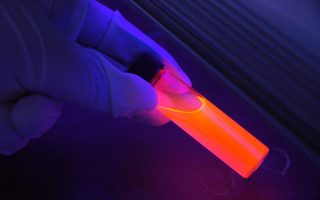
As our knowledge of COVID-19 continues to evolve, so does the pool of resources that can be used to reduce the chances of transmitting it. Social distancing, masks and rigorous surface disinfection are all now familiar methods for keeping the virus at bay. Another emerging tool in this fight is ultraviolet-C, or UV-C, light. This spectrum of light is believed to inactivate the SARS-CoV-2 virus, and some air purifiers use it as extra protection against living organisms. Here’s what you need to know about UV-C air purifiers and how they may be able to help reduce the level of the COVID-19 virus in the air.
What Is UV-C and How Does it Affect Coronaviruses?
While everyone knows what ultraviolet light is, many don’t realize that it can be divided up into different categories, designated UV-A, UV-B and UV-C. These categories reflect the effects of the UV light at different wavelengths. Ultraviolet C has the shortest range of wavelenths, from 100-280 nanometers. At this range, UV light has germicidal properties. Thanks to the ultra-short wavelengths that characterize it, UV-C light can disrupt the chemical bonds of DNA molecules, allowing it to inactivate viruses and bacteria quite effectively.
UV-C has long been known to kill off coronaviruses in the same family as SARS-CoV-2. The laboratory standard for these similar viruses is UV-C light at a 254 nanometer wavelength applied at a dosage of 20 millijoules per square centimeter. Because the SARS-CoV-2 virus is so new, though, most experts have advised erring on the side of caution with a considerably higher dosage of UV-C light to ensure that it is rendered inactive.
UV-C Air Purifiers
When a UV-C germicidal lamp is built into an air purifier, it can add an extra layer of protection against viruses, bacteria and mold spores in the air. As air is passed through the purifier’s internal irradiation chamber, it is exposed to UV-C light. This allows the purifier to reduce these biological contaminants. While many such contaminants will get captured in HEPA filters anyway, the UV-C lamp can offer added peace of mind.
But Wait, I Thought COVID-19 Wasn’t Spread Through the Air?
Since COVID-19 became a worldwide pandemic, experts, researchers and health services have debated back and forth over how the disease spreads. At different points, airborne transmission, coughing and sneezing from infected people, person-to-person contact and even surface spread have held favor as the main transmission pathway for the virus. While it could be quite a while before we know for sure, airborne transmission has recently returned to the spotlight as a major driver of the pandemic.
Recently, a group of 239 experts joined together in an open letter warning that evidence strongly suggests that COVID-19 is being transmitted in an aerosol form. As a result, the social distancing measures currently in place may not be sufficient to stop or slow down the spread of the virus. The probability of airborne spread means that proper use of face masks is even more important than previously believed. It also supports the use of air purification technologies that may reduce the amount of the virus in indoor air.
What Are Some of the Best UV-C Air Purifiers?
If you’re looking for a good UV-C air purifier, we have several models to choose from. Some of our top ultraviolet air purifiers are listed below for your convenience:
Have questions about which UV-C air purifier is the right choice for your home? We’re here to help! Feel free to contact us, and we’ll be happy to help you select the unit that’s the best fit for your needs.